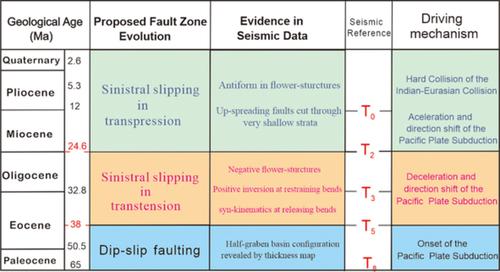当前位置:
X-MOL 学术
›
Geolog. J.
›
论文详情
Our official English website, www.x-mol.net, welcomes your
feedback! (Note: you will need to create a separate account there.)
Cenozoic evolution of Zhangjiakou‐Penglai Fault Zone in the western offshore Bohai Bay Basin: Evidence from 3D seismic data
Geological Journal ( IF 1.4 ) Pub Date : 2021-01-06 , DOI: 10.1002/gj.4046 Xiao Ma 1 , Jingyan Liu 1 , Changsong Lin 1 , Huiyong Li 2 , Chengmin Niu 2
Geological Journal ( IF 1.4 ) Pub Date : 2021-01-06 , DOI: 10.1002/gj.4046 Xiao Ma 1 , Jingyan Liu 1 , Changsong Lin 1 , Huiyong Li 2 , Chengmin Niu 2
Affiliation

|
The Zhangjiakou‐Penglai Fault Zone (ZPFZ) is an NW‐trending strike‐slip fault zone in Eastern China that contains abundant petroleum resources and has induced massive seismic hazards. It is left‐lateral and behaves as a conjugate relationship with the Tan‐Lu Fault Zone (TLFZ). Present studies on the ZPFZ are mainly conducted on its seismology and field exposure features, with subsurface characteristics and evolution history poorly understood. In this study, we investigated the ZPFZ in the western offshore Bohai Bay Basin based on the detailed interpretation of 3D seismic data, specializing in subsurface geometric characters and evolution history. The profile flower structure and plan broom‐like pattern featured the ZPFZ in the study area and indicate its sinistral strike‐slipping. We further investigated and discusssd the Cenozoic evolution history based on evidence in (a) distinguished tectonics in fault releasing and restraining bends, (b) strata thickness map before and after the strike‐slipping, and (c) geometry of composite flower structures. The result suggests the evolution of the ZPFZ mainly comprises three stages: (a) the initial extension from 65 to 38 Ma, (b) the sinistral strike‐slipping in transtension from 38 to 25 Ma, and (3) the sinistral strike‐slipping in transpression from 25 Ma to present. The proposed evolution of the ZPFZ had good consistency with that of the conjugate TLFZ and was closely related to the Cenozoic surrounding plate tectonism, especially the Pacific Plate subduction.
更新日期:2021-01-06









































 京公网安备 11010802027423号
京公网安备 11010802027423号